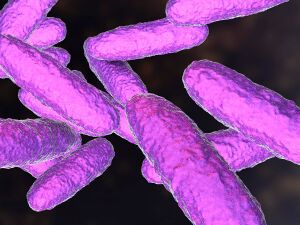User:Amb4321: Difference between revisions
(Created page with "Klebsiella granulomatis") |
No edit summary |
||
| (4 intermediate revisions by the same user not shown) | |||
| Line 1: | Line 1: | ||
Klebsiella granulomatis | '''Klebsiella Granulomatis''' | ||
{{Uncurated}} | |||
[[Image:Klebsiella granulomatis.jpeg|thumb|300px|right|Legend. Image credit: Name or Publication.]] | |||
==Classification== | |||
Bacteria; Psuedomonadota; Gammaproteobacteria; Enterobacterales; Enterobacteriaceae [Others may be used. Use | |||
[http://www.ncbi.nlm.nih.gov/Taxonomy/ NCBI] link to find] | |||
===Species=== | |||
{| | |||
| height="10" bgcolor="#FFDF95" | | |||
'''NCBI: | |||
[https://www.ncbi.nlm.nih.gov/Taxonomy/Browser/wwwtax.cgi?mode=Info&id=1007084&lvl= | |||
]''' | |||
|} | |||
''Klebsiella, K. granulomatis'' | |||
==Description and Significance== | |||
Describe the appearance, habitat, etc. of the organism, and why you think it is important. | |||
==Genome Structure== | |||
Describe the size and content of the genome. How many chromosomes? Circular or linear? | |||
Other interesting features? What is known about its sequence? | |||
==Cell Structure, Metabolism and Life Cycle== | |||
Interesting features of cell structure; how it gains energy; what important molecules it produces. | |||
==Ecology and Pathogenesis== | |||
Habitat; symbiosis; biogeochemical significance; contributions to environment.<br> | |||
If relevant, how does this organism cause disease? Human, animal, plant hosts? Virulence | |||
factors, as well as patient symptoms.<br><br> | |||
==References== | |||
[Sample reference] [http://ijs.sgmjournals.org/cgi/reprint/50/2/489 Takai, K., Sugai, A., Itoh, T., | |||
and Horikoshi, K. "''Palaeococcus ferrophilus'' gen. nov., sp. nov., a barophilic, | |||
hyperthermophilic archaeon from a deep-sea hydrothermal vent chimney". ''International Journal | |||
of Systematic and Evolutionary Microbiology''. 2000. Volume 50. p. 489-500.] | |||
==Author== | |||
Page authored by Ashley Byrd, student of Prof. Bradley Tolar at UNC Wilmington. | |||
<!-- Do not remove this line-->[[Category:Pages edited by students of Bradley Tolar at UNC | |||
Wilmington]] | |||
Latest revision as of 11:41, 14 November 2022
Klebsiella Granulomatis
Classification
Bacteria; Psuedomonadota; Gammaproteobacteria; Enterobacterales; Enterobacteriaceae [Others may be used. Use NCBI link to find]
Species
|
NCBI: [https://www.ncbi.nlm.nih.gov/Taxonomy/Browser/wwwtax.cgi?mode=Info&id=1007084&lvl= ] |
Klebsiella, K. granulomatis
Description and Significance
Describe the appearance, habitat, etc. of the organism, and why you think it is important.
Genome Structure
Describe the size and content of the genome. How many chromosomes? Circular or linear? Other interesting features? What is known about its sequence?
Cell Structure, Metabolism and Life Cycle
Interesting features of cell structure; how it gains energy; what important molecules it produces.
Ecology and Pathogenesis
Habitat; symbiosis; biogeochemical significance; contributions to environment.
If relevant, how does this organism cause disease? Human, animal, plant hosts? Virulence
factors, as well as patient symptoms.
References
[Sample reference] [http://ijs.sgmjournals.org/cgi/reprint/50/2/489 Takai, K., Sugai, A., Itoh, T., and Horikoshi, K. "Palaeococcus ferrophilus gen. nov., sp. nov., a barophilic, hyperthermophilic archaeon from a deep-sea hydrothermal vent chimney". International Journal of Systematic and Evolutionary Microbiology. 2000. Volume 50. p. 489-500.]
Author
Page authored by Ashley Byrd, student of Prof. Bradley Tolar at UNC Wilmington.
[[Category:Pages edited by students of Bradley Tolar at UNC Wilmington]]

